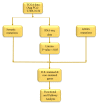Interactions between Germline and Somatic Mutated Genes in Aggressive Prostate Cancer
- PMID: 31007957
- PMCID: PMC6441536
- DOI: 10.1155/2019/4047680
Interactions between Germline and Somatic Mutated Genes in Aggressive Prostate Cancer
Abstract
Prostate cancer (PCa) is the most common diagnosed malignancy and the second leading cause of cancer-related deaths among men in the USA. Advances in high-throughput genotyping and next generation sequencing technologies have enabled discovery of germline genetic susceptibility variants and somatic mutations acquired during tumor formation. Emerging evidence indicates that germline variations may interact with somatic events in carcinogenesis. However, the possible oncogenic interactions and cooperation between germline and somatic variation and their role in aggressive PCa remain largely unexplored. Here we investigated the possible oncogenic interactions and cooperation between genes containing germline variation from genome-wide association studies (GWAS) and genes containing somatic mutations from tumor genomes of 305 men with aggressive tumors and 52 control samples from The Cancer Genome Atlas (TCGA). Network and pathway analysis were performed to identify molecular networks and biological pathways enriched for germline and somatic mutations. The analysis revealed 90 functionally related genes containing both germline and somatic mutations. Transcriptome analysis revealed a 61-gene signature containing both germline and somatic mutations. Network analysis revealed molecular networks of functionally related genes and biological pathways including P53, STAT3, NKX3-1, KLK3, and Androgen receptor signaling pathways enriched for germline and somatic mutations. The results show that integrative analysis is a powerful approach to uncovering the possible oncogenic interactions and cooperation between germline and somatic mutations and understanding the broader biological context in which they operate in aggressive PCa.
Figures





Similar articles
-
Integrating Germline and Somatic Mutation Information for the Discovery of Biomarkers in Triple-Negative Breast Cancer.Int J Environ Res Public Health. 2019 Mar 23;16(6):1055. doi: 10.3390/ijerph16061055. Int J Environ Res Public Health. 2019. PMID: 30909550 Free PMC article.
-
Integrating germline and somatic variation information using genomic data for the discovery of biomarkers in prostate cancer.BMC Cancer. 2019 Mar 14;19(1):229. doi: 10.1186/s12885-019-5440-8. BMC Cancer. 2019. PMID: 30871495 Free PMC article.
-
Delineation of the Germline and Somatic Mutation Interaction Landscape in Triple-Negative and Non-Triple-Negative Breast Cancer.Int J Genomics. 2020 Jul 6;2020:2641370. doi: 10.1155/2020/2641370. eCollection 2020. Int J Genomics. 2020. PMID: 32724790 Free PMC article.
-
Aligning germline and somatic mutations in prostate cancer. Are genetics changing practice?BJU Int. 2023 Nov;132(5):472-484. doi: 10.1111/bju.16120. Epub 2023 Jul 27. BJU Int. 2023. PMID: 37410655 Review.
-
Germline Variants Impact Somatic Events during Tumorigenesis.Trends Genet. 2019 Jul;35(7):515-526. doi: 10.1016/j.tig.2019.04.005. Epub 2019 May 22. Trends Genet. 2019. PMID: 31128889 Free PMC article. Review.
Cited by
-
Elucidation of the Genomic-Epigenomic Interaction Landscape of Aggressive Prostate Cancer.Biomed Res Int. 2021 Jan 13;2021:6641429. doi: 10.1155/2021/6641429. eCollection 2021. Biomed Res Int. 2021. PMID: 33511206 Free PMC article.
-
Germline variant screening with targeted next generation sequencing in prostate cancer: phenotype-genotype correlation.Turk J Med Sci. 2022 Feb;52(1):131-143. doi: 10.3906/sag-2105-348. Epub 2022 Feb 22. Turk J Med Sci. 2022. PMID: 34579513 Free PMC article.
-
Mapping the Germline and Somatic Mutation Interaction Landscape in Indolent and Aggressive Prostate Cancers.J Oncol. 2019 Nov 13;2019:4168784. doi: 10.1155/2019/4168784. eCollection 2019. J Oncol. 2019. PMID: 31814827 Free PMC article.
-
A computational and structural analysis of germline and somatic variants affecting the DDR mechanism, and their impact on human diseases.Sci Rep. 2021 Jul 12;11(1):14268. doi: 10.1038/s41598-021-93715-6. Sci Rep. 2021. PMID: 34253785 Free PMC article.
-
Racial disparity in the genomics of precision oncology of prostate cancer.Cancer Rep (Hoboken). 2023 Sep;6 Suppl 1(Suppl 1):e1867. doi: 10.1002/cnr2.1867. Epub 2023 Aug 10. Cancer Rep (Hoboken). 2023. PMID: 37565547 Free PMC article. Review.
References
-
- American Cancer Society. Cancer Facts and Figures 2017 (Annual Report)
Grants and funding
LinkOut - more resources
Full Text Sources
Research Materials
Miscellaneous

